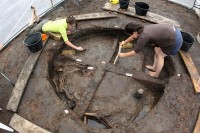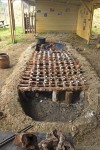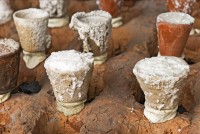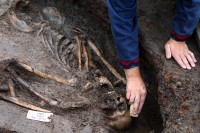 The skeletal remains of eight people have been unearthed in an ancient grain silo in Marsal, a town in the northeastern French region of Lorraine. The skeletons date to around 500 B.C. and were unceremoniously tossed into the silo so archaeologists found the bodies stacked on top of each other in random positions. Two of them were of children.
The skeletal remains of eight people have been unearthed in an ancient grain silo in Marsal, a town in the northeastern French region of Lorraine. The skeletons date to around 500 B.C. and were unceremoniously tossed into the silo so archaeologists found the bodies stacked on top of each other in random positions. Two of them were of children.
The discovery is unusual, the first of its kind in Lorraine, and may be connected with Marsal’s history as a major center for the production of salt. From the 7th to the 1st century B.C., there were extensive salt works in the area processing water from the salt springs of the upper valley of the Seille river. So far archaeologists have unearthed more than six miles of salt production complexes and at least a dozen individual workshops.
 This was production on an industrial scale. Workshops created clay grids on which little coarse ceramic molds not unlike Dixie cups in shape and size would be placed. The cups were filled with high salinity brine and wood-fueled fires lit underneath the grid. The water would boil away leaving only crystalized salt in the vessels. The molds were then broken apart, leaving a cone of salt of a conveniently standard size and a pile of broken clay. Excavations in the Marsal area have discovered trash piles of the clay discards from this process up to 40 feet high.
This was production on an industrial scale. Workshops created clay grids on which little coarse ceramic molds not unlike Dixie cups in shape and size would be placed. The cups were filled with high salinity brine and wood-fueled fires lit underneath the grid. The water would boil away leaving only crystalized salt in the vessels. The molds were then broken apart, leaving a cone of salt of a conveniently standard size and a pile of broken clay. Excavations in the Marsal area have discovered trash piles of the clay discards from this process up to 40 feet high.
 Salt’s value as a seasoning agent, and most importantly, as one of the only consistent, reliable and portable means of food preservation, made it so valuable it could be used as currency. The cones of salt left after the vessels were broken away could be traded for goods and services, just like money. That’s why their being regular in size and weight was so significant a production element, akin to the precious metal content of a coin.
Salt’s value as a seasoning agent, and most importantly, as one of the only consistent, reliable and portable means of food preservation, made it so valuable it could be used as currency. The cones of salt left after the vessels were broken away could be traded for goods and services, just like money. That’s why their being regular in size and weight was so significant a production element, akin to the precious metal content of a coin.
 Most relevantly to the skeletons in the silo, archaeologists have found an Iron Age necropolis used by the salt workers in the community, so dumping the bodies of these poor wretches in the silo was a deliberate choice. The grave goods in the necropolis burials include a range of objects of diverse value, the highest of which are expensive imports underscoring just how active and far-ranging the commercial activity of the site was, and that there was a distinctly hierarchical society in place there.
Most relevantly to the skeletons in the silo, archaeologists have found an Iron Age necropolis used by the salt workers in the community, so dumping the bodies of these poor wretches in the silo was a deliberate choice. The grave goods in the necropolis burials include a range of objects of diverse value, the highest of which are expensive imports underscoring just how active and far-ranging the commercial activity of the site was, and that there was a distinctly hierarchical society in place there.
 The remains found in the grain silo are all in good condition thanks to the watery and salty soil. Archaeologists hope testing can determine if these people worked in the salt workshops, if they were raised in the area, if they were related to each other, what they ate, what may have claimed their lives. Lead archaeologist Lawrence Olivier, who has been excavating Marsal and environs for a decade, believes they must have been people of low status, possibly slaves, perhaps victims of a massacre or an epidemic.
The remains found in the grain silo are all in good condition thanks to the watery and salty soil. Archaeologists hope testing can determine if these people worked in the salt workshops, if they were raised in the area, if they were related to each other, what they ate, what may have claimed their lives. Lead archaeologist Lawrence Olivier, who has been excavating Marsal and environs for a decade, believes they must have been people of low status, possibly slaves, perhaps victims of a massacre or an epidemic.
France’s National Institute for Preventative Archaeology (INRAP) has a comprehensive and fascinating website dedicated to Gallic salt production. If you don’t read French, browse it using an online translator because it’s downright illuminating. Here’s the section on the Bronze and Iron Age production that covers the period of the skeletons. Check the dropdowns for tons more information and pictures.